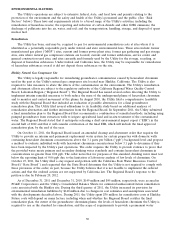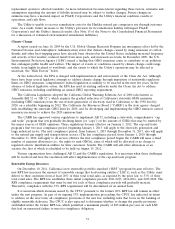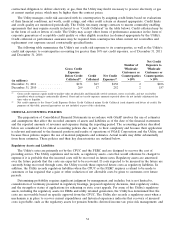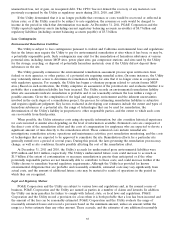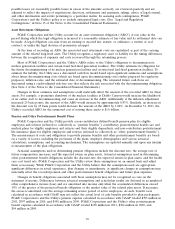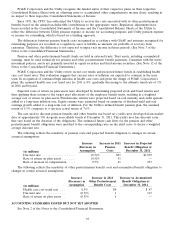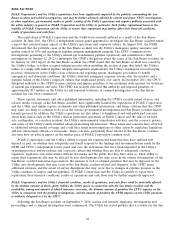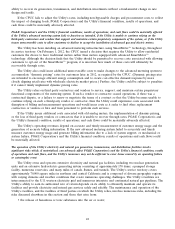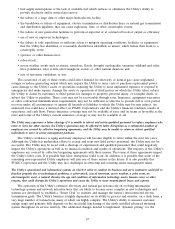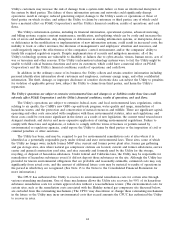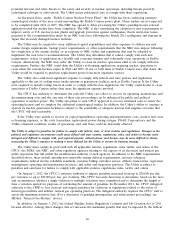PG&E 2011 Annual Report Download - page 44
Download and view the complete annual report
Please find page 44 of the 2011 PG&E annual report below. You can navigate through the pages in the report by either clicking on the pages listed below, or by using the keyword search tool below to find specific information within the annual report.with new regulatory and legislative requirements. In addition, the Utility also may incur third-party liability related to
service disruptions caused by changes in pressure on its natural gas transmission pipelines as work is performed
under the plan. If the CPUC does not allow the Utility to recover a material portion of the pipeline-related costs for
which the Utility has sought or intends to seek to recover through rates, PG&E Corporation’s and the Utility’s
financial condition, results of operations and cash flows could be materially affected.
PG&E Corporation’s and the Utility’s financial condition depends upon the Utility’s ability to recover its operating expenses
and its electricity and natural gas procurement costs and to earn a reasonable rate of return on capital investments, in a
timely manner from the Utility’s customers through regulated rates.
The Utility’s ability to recover its costs and earn its authorized rate of return can be affected by many factors,
including the time lag between the incurrence of costs and the recovery of the costs in customers’ rates. The CPUC
or the FERC may not allow the Utility to recover costs that it has already incurred on the basis that such costs were
not reasonably or prudently incurred or for other reasons. The Utility may also determine not to seek recovery of
certain costs, such as costs incurred in connection with certain pipeline-related activities. (See ‘‘Natural Gas Matters’’
above.) Further, to serve its customers in a safe and reliable manner the Utility may be required to incur expenses
before the CPUC approves the recovery of such costs, for example, to improve the safety and reliability of the
Utility’s natural gas transmission system. In such circumstances, the CPUC may allow the Utility to track such costs
for future recovery. The Utility may not be able to recover costs incurred before the CPUC allows the costs to be
tracked or if the CPUC does not permit the costs to be tracked.
In addition, fluctuating commodity prices, changes in laws and regulations or changes in the political and
regulatory environment may have an adverse effect on the Utility’s ability to timely recover its costs and earn its
authorized rate of return. For example, during the 2000 through 2001 energy crisis the market mechanism flaws in
California’s newly established wholesale electricity market led to dramatically high market prices for electricity that
the Utility was unable to recover through customer rates ultimately causing the Utility to file a petition for
reorganization under Chapter 11 of the U.S. Bankruptcy Code. Although current law and regulatory mechanisms
permit the Utility to pass through its costs to procure electricity and natural gas, including the costs associated with
the Utility’s derivative contracts, a significant and sustained rise in commodity prices could cause public policymakers
and customers to demand rate relief. In response to this pressure, the CPUC could be more likely to disallow the
Utility’s costs to ease the rate burdens. This pressure could increase as the Utility continues to collect authorized
rates to support public purpose programs, such as energy efficiency programs, and low-income rate subsidies, and to
fund customer incentive programs. In addition, legislation or regulations may be adopted in the future that could
adversely affect the Utility’s ability to recover its costs.
The Utility’s ability to recover its costs also may be impacted by the economy and the economy’s corresponding
impact on the Utility’s customers. For example, during the last economic downturn, customer growth slowed and
customer demand decreased in the Utility’s service territory. Increased unemployment and a decline in the values of
residential real estate resulted in an increase in unpaid customer accounts receivable. A sustained downturn or
sluggishness in the economy also could reduce the Utility’s sales to industrial and commercial customers. Although
the Utility generally recovers its costs through rates, regardless of sales volume, rate pressures increase when the
costs are borne by a smaller sales base. A portion of the Utility’s revenues depends on the level of customer demand
for the Utility’s natural gas transportation services which can fluctuate based on economic conditions, the price of
natural gas, and other factors.
The Utility’s failure to recover any material amount of its costs through its rates in a timely manner would have
a material effect on PG&E Corporation’s and the Utility’s financial condition, results of operations, and cash flows.
The Utility’s ability to procure electricity to meet customer demand at reasonable prices and recover procurement costs timely
may be affected by increasing renewable energy requirements, new state cap-and trade regulations, and the continuing
functioning of the wholesale electricity market in California.
The Utility meets customer demand for electricity from a variety of sources, including electricity generated from
the Utility’s own generation facilities, electricity provided by third parties under power purchase contracts, and
purchases on the wholesale electricity market. The Utility must manage these sources using the principles of ‘‘least
cost dispatch.’’ If the CPUC found that the Utility did not act prudently in following the principles of least cost
dispatch, the CPUC could disallow costs that the CPUC determined the Utility incurred as a result of the imprudent
action.
40


